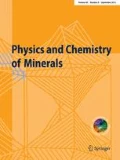Abstract
The incorporation of hydrogen (deuterium) into the coesite structure was investigated at pressures from 3.1 to 7.5 GPa and temperatures of 700, 800, and 1100 °C. Hydrogen could only be incorporated into the coesite structure at pressures greater 5.0 GPa and 1100 °C . No correlation between the concentration of trace elements such as Al and B and the hydrogen content was observed based on ion probe analysis (1335 ± 16 H ppm and 17 ± 1 Al ppm at 7.5 GPa, 1100 °C). The FTIR spectra show three relatively intense bands at 3575, 3516, and 3459 cm−1 (ν1 to ν3, respectively) and two very weak bands at 3296 and 3210 cm−1 (ν4 and ν5, respectively). The band at 3516 cm−1 is strongly asymmetric and can be resolved into two bands, 3528 (ν2a) and 3508 (ν2b) cm−1, with nearly identical areas. Polarized infrared absorption spectra of coesite single-crystal slabs, cut parallel to (0 1 0) and (1 0 0), were collected to locate the OH dipoles in the structure and to calibrate the IR spectroscopy for quantitative analysis of OH in coesite (ɛ i ,tot=190 000 ± 30 000 l mol−1 H2O cm−2). The polarized spectra revealed a strong pleochroism of the OH bands. High-pressure FTIR spectra at pressures up to 8 GPa were performed in a diamond-anvil cell to gain further insight into incorporation mechanism of OH in coesite. The peak positions of the ν1, ν2, and ν3 bands decrease linearly with pressure. The mode Grüneisen parameters for ν1, ν2, and ν3 are −0.074, −0.144 and −0.398, respectively. There is a linear increase of the pressure derivatives with band position which follows the trend proposed by Hofmeister et al. (1999). The full widths at half maximum (FWHM) of the ν1, ν2, and ν3 bands increase from 35, 21, and 28 cm−1 in the spectra at ambient conditions to 71, 68, and 105 in the 8 GPa spectra, respectively. On the basis of these results, a model for the incorporation of hydrogen in coesite was developed: the OH defects are introduced into the structure by the substitution Si4+(Si2)+4O2−= [4]□(Si2) + 4OH−, which gives rise to four vibrations, ν1, ν2a, ν2b, and ν3. Because the OH(D)-bearing samples do contain traces of Al and B, the bands ν4 and ν5 may be coupled to Al and/or B substitution.
Similar content being viewed by others
Author information
Authors and Affiliations
Additional information
Received: 19 December 2000 / Accepted: 23 April 2001
Rights and permissions
About this article
Cite this article
Koch-Müller, M., Fei, Y., Hauri, E. et al. Location and quantitative analysis of OH in coesite. Phys Chem Min 28, 693–705 (2001). https://doi.org/10.1007/s002690100195
Issue Date:
DOI: https://doi.org/10.1007/s002690100195




